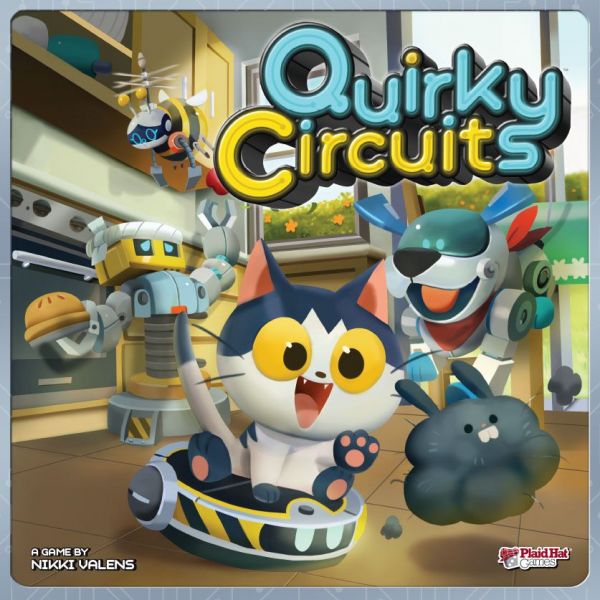Successfully Program Robotic Animals in Quirky Circuits

Guide cute critters across multiple modes in this action programming gem from designer Nikki Valens.
Gameplay
Quirky Circuits is a cooperative game for 2-4 players and published as part of Plaid Hat Games' storyboard series. Each of these games has taken inspiration from books by presenting boards that have multiple pages, thus creating modules that provide variable challenges.
This is no different for Quirky Circuits, which thrives in this environment due to its action programming mechanic. Players join together to guide one of the four animal characters (Gizmo, Lefty, Twirl, and Rover) around a different area collecting items and completing tasks before the battery runs out. Each of these characters are different not only in which scenarios they are used in, but in what they collect, how they interact with the environment, and their special set of cards and unique powers.
Each of the 24 scenarios will include their own set of rules that players must follow. Players will then deal an amount of cards determined by the player count and place the rest face down. After looking at their cards, players will be unable to speak to each other to communicate what cards they have (aside from the recommended “beep boop” prompt) before placing cards in a queue to move the robotic animal. Without being able to utter a word, players will have to figure out what cards each other is playing and try to determine if they are on the same wavelength. After at least five cards have been played into the queue (and every player must contribute one card), the cards are revealed one by one and the animal moved accordingly.
In the first scenario, Gizmo is used. He is a cat riding on an automated vacuum to collect dust bunnies. If players are successful within his scenario, they will collect multiple dust bunnies scattered across a room’s parameter using his forward, backward, left and right turns, and turn around cards. Gizmo also has a special power which causes him to turn left when he bumps into a wall or an obstacle. The first scenario prepares you for the second scenario, where vases are added to pinch points that, if bumped by Gizmo, will fall and must also be cleaned up.
A scenario is successfully completed if the animal carries out the tasks and returns to a set point before the battery runs out. The battery is a track that includes the number of rounds allowed for players to complete the task(s) outlined in the scenario.

Review
Despite its simplistic approach, Quirky Circuits is anything but easy.
As imagined, the non-verbal communication within Quirky Circuits is the biggest challenge. Similar to The Mind, players must be able to figure out what each person is playing without speaking or making grand gestures. Order is not only important, but how many spaces are being advanced could also be at play. This only becomes more arduous as the robot’s movements do not pan out and players must now problem solve how to navigate from this point as a collective.
The gameplay itself is relatively easy. Each animal robot has their own deck of cards with similar, but not entirely the same, movements. While it may be tempting to skip scenarios to try each animal at the beginning, it’s better to follow the storyboard from page to page so as to gain an understanding of the movements, powers, and limitations of each robot. Likewise, knowing when and how to leverage each robot’s unique power is a must. Returning to the beginning scenario, knowing you can force Gizmo to turn left by bumping him and his floor vacuum into a wall or an obstacle may help players get out of a tight situation by using a forward card when no one has a left turn. However, in the second scenario, there will be vases that will fall from their pedestals and break when bumped that may cause players to have to backtrack to pick up the broken pieces. This may cause additional programming headaches as well as cost players a round or two on the battery track trying to navigate to the broken pieces and to get back into the main focus of gathering up the remaining dust bunnies.
Playing with children will offer the best and worst of Quirky Circuits. It is a game that will teach parents and children patience, but if all parties involved go into the game looking for a good, fun time they will most certainly receive it. That children are learning rudimentary programming while also playing a fun game in a low-stakes environment is a win-win for all parties involved. As for adults, if they follow the rules and ditch all the verbal communique and body language, there is still some difficulty involved.
Some may find that Quirky Circuits is not a game so much as a tool in bettering one’s communication skills when faced with limitations. But much like The Mind, or even card games such as Poker and Blackjack, playing the other players is in itself an entire genre of gaming. And that’s the crux of Quirky Circuits: being able to mind meld with players, try to suss out what is being played face down in the queue, and making cards sync well. Sometimes, players will have a bad hand and they need to play a card to fit the requirement that everyone plays at least one card into the queue — this provide its own brain-burning puzzle.
All of this in a game that will take no more than 30 minutes to play. Quirky Circuits won’t provide a brain break between heavier games during game night, but it will lend moments of thinky fun to the evening’s events.
Pros: Easy to learn and difficult to master, Cute action programming that is accessible to children and fun for adults, Great presentation and variability
Cons: Limits to communication may be frustrating to some




